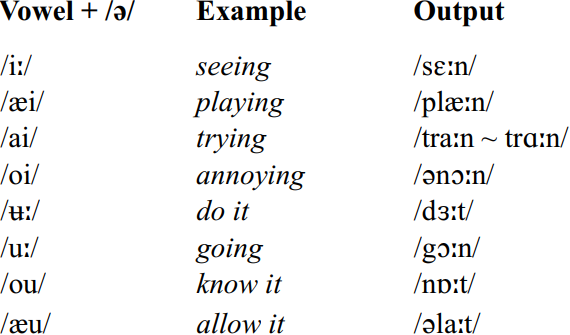

Grammar


Tenses


Present

Present Simple

Present Continuous

Present Perfect

Present Perfect Continuous


Past

Past Continuous

Past Perfect

Past Perfect Continuous

Past Simple


Future

Future Simple

Future Continuous

Future Perfect

Future Perfect Continuous

Passive and Active


Parts Of Speech


Nouns

Countable and uncountable nouns

Verbal nouns

Singular and Plural nouns

Proper nouns

Nouns gender

Nouns definition

Concrete nouns

Abstract nouns

Common nouns

Collective nouns

Definition Of Nouns


Verbs

Stative and dynamic verbs

Finite and nonfinite verbs

To be verbs

Transitive and intransitive verbs

Auxiliary verbs

Modal verbs

Regular and irregular verbs

Action verbs


Adverbs

Relative adverbs

Interrogative adverbs

Adverbs of time

Adverbs of place

Adverbs of reason

Adverbs of quantity

Adverbs of manner

Adverbs of frequency

Adverbs of affirmation


Adjectives

Quantitative adjective

Proper adjective

Possessive adjective

Numeral adjective

Interrogative adjective

Distributive adjective

Descriptive adjective

Demonstrative adjective


Pronouns

Subject pronoun

Relative pronoun

Reflexive pronoun

Reciprocal pronoun

Possessive pronoun

Personal pronoun

Interrogative pronoun

Indefinite pronoun

Emphatic pronoun

Distributive pronoun

Demonstrative pronoun


Pre Position


Preposition by function

Time preposition

Reason preposition

Possession preposition

Place preposition

Phrases preposition

Origin preposition

Measure preposition

Direction preposition

Contrast preposition

Agent preposition


Preposition by construction

Simple preposition

Phrase preposition

Double preposition

Compound preposition


Conjunctions

Subordinating conjunction

Correlative conjunction

Coordinating conjunction

Conjunctive adverbs


Interjections

Express calling interjection


Grammar Rules

Preference

Requests and offers

wishes

Be used to

Some and any

Could have done

Describing people

Giving advices

Possession

Comparative and superlative

Giving Reason

Making Suggestions

Apologizing

Forming questions

Since and for

Directions

Obligation

Adverbials

invitation

Articles

Imaginary condition

Zero conditional

First conditional

Second conditional

Third conditional

Reported speech


Linguistics

Phonetics

Phonology


Semantics


Pragmatics

Linguistics fields

Syntax

Morphology

Semantics

pragmatics

History

Writing

Grammar

Phonetics and Phonology

Semiotics


Reading Comprehension

Elementary

Intermediate

Advanced


Teaching Methods

Teaching Strategies
Smoothing
المؤلف:
Peter Trudgill
المصدر:
A Handbook Of Varieties Of English Phonology
الجزء والصفحة:
172-8
2024-03-05
1029
Smoothing
We have already noted that earlier ingliding diphthongs have become monophthongs:  in near, /εə/ > /ε:/ in square. This is also true of
in near, /εə/ > /ε:/ in square. This is also true of  in poor,
in poor,  in pore, and (presumably)
in pore, and (presumably)  in pure. This development has also occurred in original triphthongs, giving tower /ta:/ and fire /fa:/ in working-class speech – the vowel /a:/ occurs only as a result of smoothing. In middle class speech, however, in which /a:/ is more central, /a:/ does not occur, and tar and tower are homophonous.
in pure. This development has also occurred in original triphthongs, giving tower /ta:/ and fire /fa:/ in working-class speech – the vowel /a:/ occurs only as a result of smoothing. In middle class speech, however, in which /a:/ is more central, /a:/ does not occur, and tar and tower are homophonous.
This historical process involving lowering before /ə/ and then loss of /ə/ is paralleled by a synchronic phonological process which carries across morpheme and word boundaries, and extends to additional vowels. (In examining the following examples, recall that East Anglia has /ə/ in most unstressed syllables where many other accents have  .) The full facts can be summarized as follows:
.) The full facts can be summarized as follows:

Thus, do it is homophonous with dirt and going rhymes with lawn. The vowels /æ:/, /a:/,  occur only as a result of smoothing. Interestingly, some speakers in Norwich pronounce towel as /tз:l/. Smoothing is most typical of the northern zone of East Anglia, but is currently spreading southwards (Trudgill 1986).
occur only as a result of smoothing. Interestingly, some speakers in Norwich pronounce towel as /tз:l/. Smoothing is most typical of the northern zone of East Anglia, but is currently spreading southwards (Trudgill 1986).















 قسم الشؤون الفكرية يصدر مجموعة قصصية بعنوان (قلوب بلا مأوى)
قسم الشؤون الفكرية يصدر مجموعة قصصية بعنوان (قلوب بلا مأوى) قسم الشؤون الفكرية يصدر مجموعة قصصية بعنوان (قلوب بلا مأوى)
قسم الشؤون الفكرية يصدر مجموعة قصصية بعنوان (قلوب بلا مأوى) قسم الشؤون الفكرية يصدر كتاب (سر الرضا) ضمن سلسلة (نمط الحياة)
قسم الشؤون الفكرية يصدر كتاب (سر الرضا) ضمن سلسلة (نمط الحياة)

















